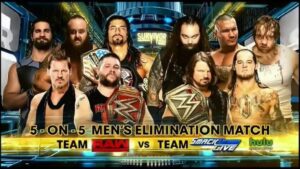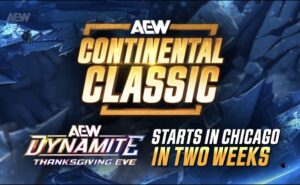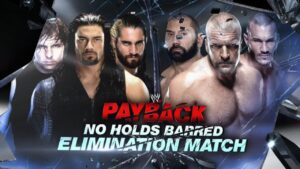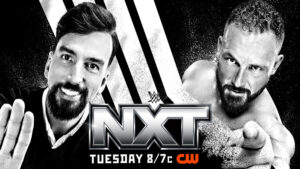For most of the past twenty years, two men have sat atop a throne in their respective countries as the biggest superstars of their respective brands. In the United States, John Cena held court over World Wrestling Entertainment (WWE) as the World Conqueror (a savior to some, a menace to others), while in the Far East, Hiroshi Tanahashi was the supreme Emperor of New Japan Pro Wrestling (NJPW). Both have dominated the main event scene at countless major pay-per-views, held multiple World championships, and even entered their respective country’s film industry. Their entire careers run near parallel, in terms of growth, ascension, and. accolades, but each tells a vastly different story of how their presence affected each of their own kingdoms.
Hiroshi Tanahashi & John Cena: In The Beginning
Both men started out early in sports, but once they headed to University they took different paths. Tanahashi left his baseball days at high school and became a collegiate amateur wrestler at Ritsumeikan University in Tokyo, where he studied law, while Cena played college football with Springfield College in Massachusetts, graduating with a degree in exercise physiology and body movement. While in University, Hiroshi Tanashi was recruited by NJPW and he began training at the New Japan Dojo in 1998, in a Young Lions class that included Shinsuke Nakamura, Katsuyori Shibata, Kendo Suzuki, and Wataru Inoue. Tanahashi made his Young Lion debut on a New Japan stage at Kōrakuen Hall in Tokyo in a loss to an older Young Lion, Shinya Makabe (before he would become better known as Togi Makabe) on October 9, 1999 at NJPW Final Dome.
 Hiroshi Tanahashi as a New Japan Young Lion
Hiroshi Tanahashi as a New Japan Young Lion
In 1999, Cena headed to the West Coast and began training with Ultimate Pro Wrestling (UPW) in Santa Ana, California, where he trained in a class that also included Samoa Joe, Rocky Romero, Christopher Daniels, and Frankie Kazarian. He made his UPW debut on November 11, 1999, just over a month after Tanahashi’s own debut. In early 2001, Cena signed with the WWE, and that June was sent to Ohio Valley Wrestling (OVW), where he would join an impressive class that featured Batista, Brock Lesnar, Randy Orton, Shelton Benjamin, and Victoria. Cena made his OVW debut for the WWE on June 27, 2001, in a tag match with Mr. Black against The Big Show & Mark Henry. Both were outstanding young prospects, with Tanahashi winning the Young Lion Award in 2001 from NJPW, while John Cena would win the OVW Heavyweight Championship and hold it for 84-days.
 John Cena as The Prototype in 1999
John Cena as The Prototype in 1999
Hiroshi Tanahashi & John Cena: The Ascension
In 2002, Hiroshi Tanahashi would make his debut at NJPW’s flagship event at Tokyo Dome, held every year on January 4 since 1992 (although under differing names until rebranding as Wrestle Kingdom in 2007). At the time, Tanahashi was in a tag team with his Dojo classmate Kendo Suzuki known as The King of the Hills, and at NJPW Wrestling World 2002, they lost to the team of Yuki Ishikawa & Kazunari Murakami. In 2003, he won the short-lived IWGP Under-3o Openweight Championship, a title that Tanahashi would hold twice in the titles two-year existence, once for 622 days and the second for 354 days (and the belt’s final champion). He had moved onto singles competition after winning his first championship in New Japan – the IWGP Tag Team titles – as part of a tag team with Yutaka Yoshie, and then briefly held Pro Wrestling NOAH‘s GHC Tag Team titles during a tour where he competed alongside veteran Yuji Nagata, who had just lost his IWGP Heavyweight title. His presence and growth during his lengthy runs as the U-30 Champion showed that Tanahashi was ready to be handed more responsibility and exposure in NJPW, culminating in Tanahashi defending his U-30 title against Nakamura on January 4 in 2005 at NJPW Wrestling World 2005 (and his first of 10 main events on a January 4 card). But it took Antonio Inoki’s departure in 2005 to cause the dramatic shift that would be necessary to bring more focus on the charismatic Hiroshi. New Japan had been in a rate of decline for the past few years, as Inoki was trying to blend more MMA qualities into the product. It was a long way from NJPW’s heydays of the 1970s through the early 1990s. With Inoki gone, New Japan’s new ownership, Japanese video game developers Yuke’s, wanted to inject more fun into the product and target a new younger audience. Tanahashi was perfect.
But while Tanahashi was poised to become the new heir apparent for NJPW, Cena initially started off with a stutter instead of a thunder. After several dark matches and WWE Live Event shows in 2001 and early 2002, John Cena debuted in the WWE Universe with a bang. On June 6, 2002 – just months after Tanahashi made his January 4 debut – Cena debuted on WWE SmackDown! to answer an open challenge by Kurt Angle. After an impressive showing, it seemed that John Cena was ready to become a big player for WWE. But after a promising feud with Chris Jericho, Cena began to slide and was soon in a tag team of his own, with Billy Kidman. During their quest to become the inaugural SmackDown Tag Team Champions, Cena would eventually turn on Kidman and become a heel, but the fans’ interest was waning. That October on the WWE Halloween Special, Cena appeared dressed like a rapper and began to freestyle. It went over so well that his character soon became a heel rapper known as “The Doctor of Thuganomics”. Despite still being a heel, Cena’s new persona soon became a guilty pleasure to a lot of fans. By 2003, the fans were completely behind him and at Survivor Series that year he became a fan favorite once again, as part of Kurt Angle’s team. The freestyling character of John Cena was quickly becoming one of WWE’s most popular new stars since the Attitude Era. He rose to the top of the mid-card, winning the WWE United States Championship three times between 2004 and 2005.
Hiroshi Tanahashi & John Cena: The Coronation
John Cena had his first WWE World title shot at WWE Backlash on April 27, 2003 (in a loss to Brock Lesnar), but it would be some time before he would become a player in that battlefield. It was just over a year later when Tanahashi got his first opportunity at the IWGP Heavyweight title when he lost to Kazuyuki Fujita for the vacant championship on June 5, 2004, during Best of the Super Juniors 11. Like Cena, this was just a taste. Tanahashi would also have to wait a little longer to become a main event contender. Much like he received his World title shot before Tanahashi, John Cena would also be the first of the two to win his company’s top singles title. On April 3, 2005, at WrestleMania 21 in Los Angeles, California, Cena defeated JBL to win the WWE World Championship.
Just over a year later, New Japan would find itself without an IWGP Heavyweight Champion, and on July 17, 2006, Tanahashi would win the tournament to crown the new World champion, defeating Giant Bernard (formerly Prince Albert in WWE) at NJPW Turbulence. Strangely, both men had lengthy reigns with their first World titles, with Cena barely edging Tanahashi 280 to 270 days. But it was clear that both WWE and New Japan had found the stars that would bring them both into new eras with their fans and the rest of the world. Both men would also bring their brands to other brands to target niche audiences – on January 15, 2006, Tanahashi (at the time the IWGP Heavyweight champion) appeared on the Total Nonstop Action (TNA) pay-per-view TNA Final Resolution, in a non-title match loss to TNA’s AJ Styles, while five months later, on June 11, John Cena would appear on the ECW revival pay-per-view ECW One Night Stand, where he lost the WWE Championship to ECW World Champion Rob Van Dam.
Hiroshi Tanahashi & John Cena: The Champions
After both men won their first World titles, it opened up a floodgate. Over the course of the next 15 years, John Cena would become a 16x World Champion in WWE (13x WWE Champion, 3x World Heavyweight Champion), collect two more WWE US titles, and a 4x Tag Team Champion, while winning the WWE Royal Rumble on two occasions – in 2008 and 2013. Hiroshi Tanahashi would become an 8x IWGP Heavyweight Champion, 2x IWGP Intercontinental Champion, add a third reign as IWGP Tag Team Champion, and a 3x NEVER Openweight 6-Man Tag Team Champion. He would win the prestigious NJPW G-1 Climax tournament three times – 2007, 2015, and 2018 – and the New Japan Cup twice, the inaugural one in 2005 and again in 2008. Thanks to New Japan’s alliances in the IWGP Conception, he would also win multiple titles in allied promotions, such as Revolution Pro (RevPro)‘s British Heavyweight Championship, while in Mexico, he won the CMLL World Tag Team titles and CMLL World Trios Championships in Consejo Mundial de Lucha Libre (CMLL).
Despite the great disparity between total World titles – Cena’s 16 to Tanahashi’s eight – their combined reigns were surprisingly closer in total days as actual champion. John Cena was World champion for a combined 1,408 days in WWE, while Tanahashi stretched his eight IWGP title reigns out over 1,396 days – a difference of only 12 days. If you combined every day they were a champion of some sort in their home promotions, it would have Cena at 1,882 days – just over 5 years of his 18 years in WWE, but Tanahashi’s total would be 2,456 days, nearly 7 full years. Tanahashi’s longest reign on top was his 404-day reign between 2011 and 2012, while Cena’s was his first reign, of 280 days, between 2005 and 206.
Hiroshi Tanahashi & John Cena: The Main Event
John Cena would officially become the main event of WrestleMania at WrestleMania 22 in 2006 when he successfully defended his WWE Championship against Triple H in Chicago, his first of five WrestleMania events he would have over 15 appearances at WWE’s Grandest Stage of Them All. His final WWE main event would happen at WrestleMania 29 in 2013, when he ended the comeback WWE Championship reign of Dwayne “The Rock” Johnson. Although Tanahashi appeared on the first NJPW Wrestle Kingdom in 2006, it wouldn’t be until Wrestle Kingdom II that he would score his first main event of the rebranded January 4 showcase. Like Cena, Hiroshi walked into his first main event as the company’s top champion – but unlike Cena, Tanahashi failed to defend his title, losing it to Shinsuke Nakamura. But it would mark the first of nine main events that he would incur at Wrestle Kingdom, his last coming at Wrestle Kingdom 13 in 2019, where he ended Kenny Omega‘s reign as IWGP Heavyweight Champion.
Both men would become staples of their respective company’s marquee events, either WWE’s WrestleMania or NJPW’s Wrestle Kingdom, with both men appearing in 15 of their home promotion’s events. Tanahashi has the slightly better record on the big stage, going 11-4 in his Wrestle Kingdom appearances, with wins over Taiyo Kea, Minoru Suzuki, and Kazuchika Okada (twice) in IWGP Heavyweight title defenses, IWGP Heavyweight title wins over Keiji Mutoh (Great Muta), Satoshi Kojima, and Kenny Omega, an IWGP Intercontinental title win over Nakamura (and loss to IWGP Champion Tetsuya Naito), plus a successful Intercontinental title defense against Jay White. He went 2-1 in matches that didn’t involve a championship, scoring wins over Go Shoziaki and Great O-Khan and losing to Chris Jericho. His feud with Okada from 2011 through 2013 helped establish Okada as a top player in the company’s future, which saw Tanahashi pass the torch in many ways when he lost in his challenge to Okada’s IWGP Heavyweight title at Wrestle Kingdom 10. Hiroshi won three of his eight IWGP Heavyweight titles at a Wrestle Kingdom. Technically, Hiroshi Tanahashi has also been to a WrestleMania – although it was as a fan, in attendance at WrestleMania 34 in New Orleans (he was in town for events during WrestleMania week with ROH, RevPro, and WrestleCon).
John Cena went 10-5 in his 15 appearances at WWE’s Showcase of the Immortals. He defended his WWE Championship against Triple H and Shawn Michaels, won World titles against JBL, Edge, Batista, and The Rock, won the US title from Big Show and Rusev, and failed twice in World title challenges, to Randy Orton and The Miz. In 2012, he lost in the Once In A Lifetime match against The Rock, but after its sequel bout the following year, Cena’s began to fade from the WWE’s main event. While he would still enter programs, he would continue with smaller or brief storyline angles into WrestleMania season, with matches against The Undertaker and “The Fiend” Bray Wyatt, or his mixed tag team match with then-fiance Nikki Bella versus The Miz and his wife, Maryse. John Cena won four of his thirteen WWE Championships at a WrestleMania event. While he lost his main event spot on WrestleMania, Cena would continue to help elevate newer stars with cleans losses to the like of CM Punk, Bray Wyatt, Shinsuke Nakamura, Roman Reigns, Daniel Bryan, Kevin Owens, AJ Styles, Dean Ambrose (Jon Moxley) and more. But clearly, Cena’s days in WWE were growing numbered, and not just from the main event.
Hiroshi Tanahashi & John Cena: The Twilight
Another stunning similarity between the two stars is their integration into the film and television industry of their respective countries. John Cena actually made his film debut – in an uncredited extra appearance as a gym rat – in 2000’s WCW movie, Ready to Rumble, before he joined WWE. But once the WWE machine got a hold of him, he made his acting debut in 2006 with the WWE-produced vehicle, The Marine, followed in 2009 with another WWE film, 12 Rounds in 2009. He made his TV debut in the USA Network show Psych in 2010, and in 2015 appeared as himself on an episode of NBC’s Parks & Recreation. In Japan, Tanahashi made his TV debut in the TV film, All Together in 2011 (appearing as himself), and in 2016, voiced the character Mototsugu Sakaki in the animated series Ishikawa Goemon and made his film debut the same year in the superhero film Kamen Rider Heisei Generations: Dr. Pac-Man vs. Ex-Aid & Ghost with Legend Rider.
 Hiroshi Tanahashi in “My Dad Is A Heel Wrestler” (2018, Showgate Films)
Hiroshi Tanahashi in “My Dad Is A Heel Wrestler” (2018, Showgate Films)
While Tanahashi’s forays into acting and voice work were minimal, he’s continued to work the same schedule as always, averaging approximately 125 matches a year with NJPW (until Covid reduced him to just 87 in 2020). But as John Cena’s stock in Hollywood began to soar, his work with the WWE began to wind down. After peaking at 202 matches in 2011, he’s been on a sharp decline since, dropping to 50 in 2016 to 28 by 2018. He worked only eight matches in 2019 and just one in 2020 (his WrestleMania match). But his work in Hollywood has flourished. He got bigger roles in films such as The Trainwreck, Daddy’s Home, Sisters, and The Wall, and in 2018, had a huge year with his first male lead in Blockers and a blockbuster in the Transformer film franchise entry, Bumblebee. That same year, Tanahashi would also make his biggest impact in the Japanese film market, in his own first male lead role in the independent film, My Dad Is A Heel Wrestler. But while Tanahashi is still focused full time on pro wrestling, Cena has joined his former foe Dwayne Johnson residing almost fulltime in Hollywood, with his upcoming appearance in the DC superhero film The Suicide Squad (the sequel to 2016’s Suicide Squad), directed by Guardians of the Galaxy director James Gunn. His character, Peacemaker, will also be getting a TV series on HBO MAX, with Cena reprising his role. He’s also slated for the lead in an upcoming spy film with franchise potential in The Janson Directive (based on another book series by Jason Bourne creator Robert Ludlum) and is the main villain in Fast & Furious 9, coming out in the Spring of 2021.
 John Cena in “F9: Fast & Furious 9” (2021, Universal Pictures)
John Cena in “F9: Fast & Furious 9” (2021, Universal Pictures)
Hiroshi Tanahashi & John Cena: The Epilogue
It’s clear that John Cena’s days as a full-time performer with WWE are over. He has etched his legacy in the WWE pantheon of history as a 16x World Champion, tied with Ric Flair, and his appearances will be the stuff of one-offs or cameos from now on. Where once there was a king, there now reigns a Tribal Chief who sits at the head of the table in a locker room that John Cena once patroled. As he settles into a Hollywood career along the likes of fellow former WWE World Champions (and rivals) Dwayne Johnson and Dave Bautista, John Cena’s removal from the WWE Universe has coincided with a steady decline in TV ratings for WWE – Cena has proven to be the last great mainstream star that WWE has produced. Meanwhile, Hiroshi Tanahashi remains the forever-young guiding force in New Japan. Although he’s no longer the Emperor of New Japan, Tanahashi has quietly slid into more of an Obi-Wan Kenobi role, passing the proverbial lightsabre to new heirs of the throne, like Okada and Kota Ibushi, but still able to compete at a high level – whether it’s hard battles against the likes of KENTA or SANADA, winning tag team gold with Ibushi, or facing rising new stars in NJPW at Wrestle Kingdom, like he did this past Monday against Great O-Khan. Film may still be something Hiroshi will end up in Japan, it’s still just a hobby for the former 8x IWGP Heavyweight Champion. This king remains firmly entrenched in the comings and goings of his kingdom, regardless if he’s still on the throne or not.
Photo: NJPW
But as both men enter the twilight of their careers, it’s hard not to look back at their careers and see the striking similarities that have run parallel with both men in their professional wrestling career and the utmost importance they have held in their home company’s existence. They are also almost the same age – Tanahashi, now 44 years old, was born in November of 1976, while Cena – now 43 – was born just six months later in April of 1977, debuted in the same year, and rose to prominence as the new kings to usher in the mid-2000s of both WWE and New Japan. But as Cena’s influence in WWE waned, so did WWE’s grasp on top of the world of professional wrestling. But meanwhile, Tanahashi’s explosive charisma helped rebounded a failing brand and has been the slingshot that has seen New Japan become arguably the most popular and profitable era of its existence since its founding in 1976, especially on a global scale. While neither has officially retired from pro wrestling (particularly Tanahashi), it’s safe to say that Tanahashi will have left NJPW a better company than when he began there. Unfortunately, John Cena will not be able to say the same (although to be fair, it was hardly Cena’s fault for WWE’s current state of affairs). But the two decades that started the 21st century were undoubtedly ruled by two very different Kings, who took very similar journeys in creating a legacy that will last a lifetime.
 Photo: Gregory Pace/Shutterstock
Photo: Gregory Pace/Shutterstock
Stay tuned to Last Word on Pro Wrestling for more on this and other stories from around the world of wrestling, as they develop. You can always count on LWOPW to be on top of the major news in the wrestling world, as well as to provide you with analysis, previews, videos, interviews, and editorials on the wrestling world.
Looking to talk wrestling, pro football, or any number of sports? Head on over to the LWOS Boards to engage in conversation with fellow fans!











